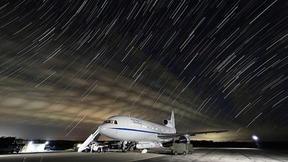Lawrence Livermore geophysicist receives NNSA Administrator's Gold Award
Lawrence Livermore National Laboratory geophysicist and a leader in the Global Security Principal Directorate Jay Zucca has received one of the National Nuclear Security Administration’s (NNSA) top awards for his work in nonproliferation and nuclear security.
Zucca, principal deputy for Global Security, was presented with the NNSA Administrator’s Distinguished Service Gold Award Jan. 12 by Anne Harrington, the agency’s deputy administrator for Defense Nuclear Nonproliferation (DNN).
The presentation by Harrington, during a brief ceremony attended by Director Bill Goldstein and Global Security Principal Associate Director Bruce Warner, was made on behalf of NNSA Administrator Frank Klotz.
Zucca was honored for "29 years of outstanding scientific contributions and leadership for U.S. global and nuclear security and nuclear explosion monitoring."
His career has encompassed work on several programs and treaties, including the Ground-Based Nuclear Explosion Monitoring (GNEM) Program, the Source Physics Experiments and the Comprehensive Test Ban Treaty (CTBT) Organization.
"As the leader of Livermore’s GNEM Program, Jay has been both a leader and an intellectual guiding force for DNN’s activities aimed at improving U.S. nuclear explosion monitoring technical capabilities," Harrington said.
In her award presentation, Harrington cited Zucca’s scientific leadership and impact with other agencies as factors that have enabled DNN R&D to initiate a major effort to advance to the next generation of monitoring capabilities.
She called Zucca "a world-renowned leader" in the development and operation for testing and evaluation purposes of the verification system for the CTBT.
"Jay’s support to DNN has been outstanding through the years. I want to personally thank him for his dedication to the DNN mission and thank him for being one of my mentors," Harrington added.
From 1995 to 2001, Zucca led the LLNL GNEM Program, which was comprised of a team of scientists who researched and developed underground nuclear explosion monitoring methods.
Before heading the GNEM team, he was a member of the U.S. delegation to the nuclear testing talks (Threshold Test Ban Treaty/Peaceful Nuclear Explosions Treaty) during which he focused on the on-site inspection portions of the treaty from 1987 through 1990.
From 1990 through 1996, he was a member of the U.S. delegation to the conference on disarmament for the CTBT negotiations. And for nearly the past 20 years, he has been a member of the U.S. delegation to the Preparatory Commission for the CTBT Organization’s Working Group B, the international body that seeks to resolve technical issues related to the treaty.
In the early years of his LLNL career, Zucca focused on the geothermal energy program, where he developed techniques for detecting steam in geothermal reservoirs as well as working on containment activities associated with underground nuclear testing.
He received his Ph.D. in geophysics from Stanford University in 1981 and joined LLNL in 1984.
Contact
 Stephen Wampler
Stephen Wampler
[email protected]
(925) 423-3107
Related Links
National Nuclear Security Administration"Lab helps field source physics experiment"
Tags
NNSAGlobal Security
Careers
Featured Articles







